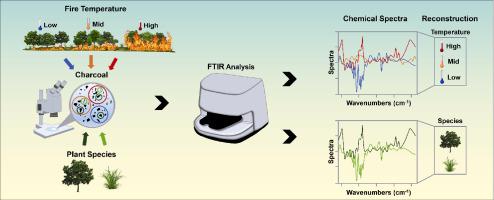Palaeogeography, Palaeoclimatology, Palaeoecology ( IF 2.6 ) Pub Date : 2021-07-24 , DOI: 10.1016/j.palaeo.2021.110580 S. Yoshi Maezumi 1 , William D. Gosling 1 , Judith Kirschner 1 , Manuel Chevalier 2, 3 , Henk L. Cornelissen 1 , Thilo Heinecke 1 , Crystal N.H. McMichael 1

|
Charcoal identification and the quantification of its abundance in sedimentary archives is commonly used to reconstruct fire frequency and the amounts of biomass burning. There are, however, limited metrics to measure past fire temperature and fuel type (i.e. the types of plants that comprise the fuel load), which are important for fully understanding the impact of past fire regimes. Here, we expand the modern reference dataset of charcoal spectra derived from micro-Fourier Transformed Infrared Spectroscopy (FTIR) and apply an analogue matching model to estimate the maximum pyrolysis temperature and the type of plant material burned. We generated laboratory-created reference charcoal from nine plant species that were heated to six temperature categories (100 °C increments between 200 °C–700 °C). The analogue matching approach used on the FTIR spectra of charcoal estimated the maximum pyrolysis temperatures with an accuracy of 57%, which improved to 93% when accuracy was considered ±100 °C. Model accuracy for the type of plant material burned was 38% at the species level, which increased to 67% when species were grouped into trait-based categories. Our results show that analogue matching is an effective approach for estimating pyrolysis temperature and the type of plant material burned, and we suggest that it can also be applied to charcoal found in palaeoecological records, improving our understanding of past fire regimes and fuel dynamics.
中文翻译:

从木炭表征火灾温度和植物物种的现代模拟匹配方法
木炭鉴定及其在沉积档案中的丰度量化通常用于重建火灾频率和生物量燃烧量。然而,衡量过去火灾温度和燃料类型(即构成燃料负荷的植物类型)的指标有限,这对于充分了解过去火灾状况的影响很重要。在这里,我们扩展了源自微傅立叶变换红外光谱 (FTIR) 的现代木炭光谱参考数据集,并应用模拟匹配模型来估计最大热解温度和燃烧的植物材料类型。我们从被加热到六个温度类别(200°C–700°C 之间的 100°C 增量)的九种植物中生成了实验室制造的参考木炭。在木炭的 FTIR 光谱上使用的模拟匹配方法以 57% 的精度估计了最大热解温度,当精度为 ±100 °C 时,精度提高到 93%。在物种水平上,燃烧的植物材料类型的模型准确度为 38%,当将物种分组为基于性状的类别时,该准确度增加到 67%。我们的结果表明,模拟匹配是估计热解温度和燃烧的植物材料类型的有效方法,我们建议它也可以应用于古生态记录中发现的木炭,提高我们对过去火灾状况和燃料动力学的理解。在物种水平上,燃烧的植物材料类型的模型准确度为 38%,当将物种分组为基于性状的类别时,该准确度增加到 67%。我们的结果表明,模拟匹配是估算热解温度和燃烧的植物材料类型的有效方法,我们建议它也可以应用于古生态记录中发现的木炭,提高我们对过去火灾状况和燃料动力学的理解。在物种水平上,燃烧的植物材料类型的模型准确度为 38%,当将物种分组为基于性状的类别时,该准确度增加到 67%。我们的结果表明,模拟匹配是估算热解温度和燃烧的植物材料类型的有效方法,我们建议它也可以应用于古生态记录中发现的木炭,提高我们对过去火灾状况和燃料动力学的理解。











































 京公网安备 11010802027423号
京公网安备 11010802027423号